TABLE IMAGE
Home » Table Image
HOW YOUR IMAGE IMPACTS YOUR OPPONENTS
In poker, understanding table image—how others perceive your playing style and actions—can be as valuable as understanding the game itself. Table image is a powerful strategic tool skilled players use to influence opponents’ decisions, control the game’s flow, and enhance their chances of winning. It goes beyond the cards; it’s about the impression you create through your moves, betting patterns, demeanor, and behavior.
Your table image constantly evolves with each decision you make, affecting how your opponents assess you and react. For example, some players establish a tight, conservative image, making bluffing highly effective as opponents assume they only play strong hands. Others might adopt a loose, aggressive persona, forcing opponents into cautious folds while they collect pots with a broader range of hands. By managing and adapting your table image, you can gain a critical advantage over other players.
Due to the detailed nature and extensive strategies involved, we’ve divided this guide into two parts. In Part 1, we’ll cover the foundational aspects of table image, including what it is, how it shifts dynamically during play, and the core strategies for building and shaping it to your advantage. Part 2, Advanced Poker Image Tactics, delves into more advanced techniques, such as exploiting opponents’ perceptions, understanding the impact of position, and adjusting table image in cash games versus tournaments.
FOUNDATIONS OF YOUR TABLE IMAGE
To fully understand table image in poker, it’s essential to break down the elements that shape it. Your table image isn’t based on just one or two actions—it’s the sum of various factors, from how you bet to how you behave at the table. These core components help form the perception others have of you, directly influencing how they play against you.
PLAYING STYLE
BETTING PATTERNS
Your overall style—tight, loose, aggressive, or passive—plays a major role in defining your table image. A tight player who only enters the pot with strong hands often creates an image of discipline and caution. In contrast, a loose player, who frequently enters pots, can appear unpredictable. Recognizing how your style impacts your image is crucial for managing opponents’ expectations.
The way you bet reveals a lot about your perceived strengths and weaknesses. Consistent, smaller bets might create a cautious or conservative image, while frequent large bets could make you appear aggressive or even reckless. Since opponents closely observe betting patterns to gauge a player’s tendencies, understanding and controlling yours is a strategic advantage.
PHYSICAL & BEHAVIORAL CUES
Subtle physical actions, like how you stack your chips or place your bets, contribute significantly to table image in poker. These details may seem minor, but they offer valuable information to observant opponents, especially in live games.

CHIP STACKING & HANDLING
CARD PROTECTORS & CONSISTENCY
The way you organize your chips reflects your demeanor and possibly your playing style. Neatly stacked chips often signal a disciplined, meticulous player, while a messy stack can convey a more relaxed or chaotic image. These cues impact how opponents view your approach to the game.
If you use a card protector, consistency is key. Place it on your cards every hand, whether you plan to fold or play. Skipping this step occasionally can reveal information unintentionally, signaling your intention to play or fold based on your habits. Small actions like this can provide observant players with a “read” on your behavior.
BETTING MECHANICS
BODY LANGUAGE & POSTURE
How you physically place your chips in the pot also adds to your table image. Some players toss their chips in with force, which may project confidence or aggression. Others carefully slide chips into the pot, creating an image of calm control. Whatever your style, aim for consistency to avoid inadvertently giving away hand strength. For instance, a change in chip handling between strong and weak hands is a common tell for attentive players.
.
Posture, even subtle movements, reveals a lot to observant opponents. For instance, leaning forward might suggest interest or confidence, while leaning back often signals uncertainty or caution. Placing your cards in the same spot on the table every hand, maintaining a neutral posture, and avoiding excessive movement or fidgeting can help reduce unwanted tells. Many players find it best to remain stoic and avoid conversation during a hand to avoid giving away cues.
CONSISTENCY ACROSS SESSIONS
For players who frequent the same cardrooms, table image can carry over from one session to the next, especially when facing familiar opponents. By maintaining a consistent image over time, you can establish yourself in a certain way—tight, loose, aggressive, etc.—allowing you to exploit that perception. Alternatively, if you find that a particular image isn’t working to your advantage, you may choose to adjust it across sessions, slowly revealing new elements of your play. Deliberately altering your image can keep your regular opponents guessing, but use caution. Shifting your image too dramatically may alert experienced players, potentially giving them the upper hand.
SELF-IMAGE VS OPPONENTS' IMAGE
Your self-image—the way you perceive your own style and tendencies—can differ from how others see you. This difference often creates opportunities for strategic play. For instance, you may see yourself as a balanced player, but if your opponents view you as overly aggressive, you can adjust your play to take advantage of their assumptions. Balancing self-perception with opponents’ perceptions helps you maintain control over your table image.

PRACTICE & OBSERVATION
SELF-AWARENESS & DISCIPLINE
Actively working on table image requires both self-awareness and observation. A simple way to improve is to bring a notebook to your sessions. Jot down observations on your actions, any tendencies you notice, and how opponents react. This helps you refine your image over time. Another effective technique is to enlist a friend or even record yourself during live play (where permitted). Reviewing footage can reveal unconscious behaviors and help you identify areas for improvement. By consistently practicing self-observation, you can fine-tune your table image and better manage how opponents perceive you.
Managing your table image requires strong self-awareness and the discipline to remain consistent in your actions. Resist the urge to make snap decisions. Instead, develop a habit—such as pausing to count to three—before making any move. This brief pause allows you to fully consider your options and prevents impulsive, irreversible actions that may inadvertently reveal information. By cultivating this mindful approach, you gain greater control over your decisions, ensuring that each action aligns with the image you aim to project.
By understanding these foundational elements, you gain greater control over your table image in poker. Each component plays a part in creating a specific persona at the poker table, influencing how opponents approach you. Recognizing and managing these elements effectively can turn table image into one of the most powerful tools in your poker strategy.
THE DYNAMICS OF TABLE IMAGE
In poker, table image is not static. It shifts and adapts as the game progresses, shaped by your actions, the changing players at the table, and the specific context of each hand. Recognizing how these dynamics influence your image is essential to staying one step ahead of your opponents. By understanding the fluid nature of table image, you can adapt your play style to capitalize on evolving perceptions, allowing you to control your opponents’ assumptions and responses.
CHANGING PERCEPTIONS DURING PLAY
ADAPTING BASEDD ON CONSISTENT ACTIONS
IMPACT OF SPECIFIC HANDS ON TABLE IMAGE
SHORT TERM VS LONG TERM MANAGEMENT
Throughout a session, your consistent actions create patterns that shape how others perceive you. For example, if you continually raise pre-flop in certain positions, opponents may begin to associate you with aggression, even when you play cautiously in other situations. Recognizing when your consistent moves are creating a clear image allows you to exploit this perception by occasionally breaking the pattern and catching opponents off-guard.
Certain memorable hands can create lasting impressions, influencing your table image for the rest of the session. For instance, a dramatic showdown in which you successfully bluff a strong opponent may lead others to view you as daring or aggressive. Conversely, folding a seemingly strong hand in a tense situation may project caution or even fear; however, it can also convey that you have a strong read on your opponent and the discipline to lay down big hands when you believe you’re beaten. This impression can make others view you as a skilled, thoughtful player, which may deter them from testing your resolve in future hands.
Your table image can vary over the short and long term. In the short term, a few consecutive aggressive moves may cause opponents to label you as loose or unpredictable. However, over the course of a full session, the broader patterns in your play style will emerge, and this longer-term image often has a more lasting impact. Skilled players can balance these two perspectives, using short-term shifts in image to secure immediate advantages while maintaining an overarching persona that benefits their long-term strategy.
AN EXAMPLE OF CHANGING TABLE IMAGE
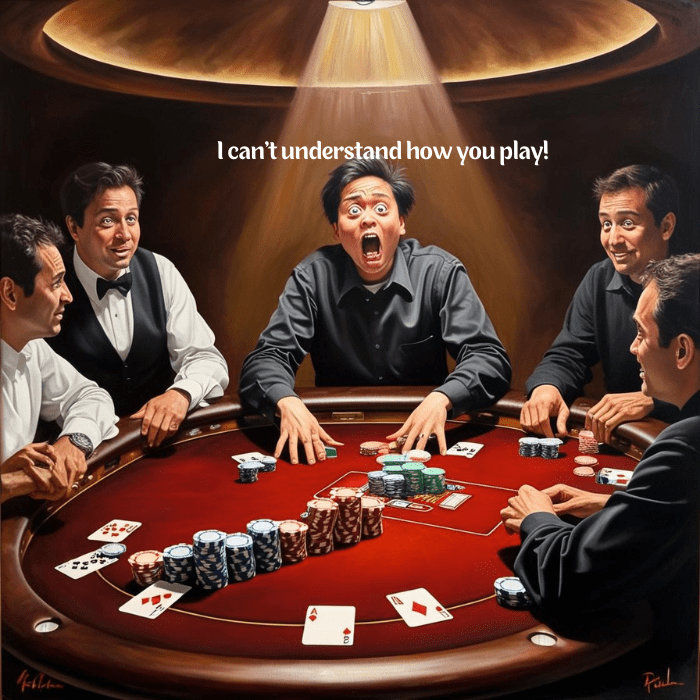
For example, I am in a game a few weeks ago. For the first 90 minutes, I folded nearly every hand I was dealt. I occasionally called and missed the flop. Then, I consecutively received several good hands and played about ten in a row, winning all but one. Around my fifth hand, a player across the table stared at me and said, “I can’t figure you out; first, you play no hands, and now you play every hand.” I just smiled and replied, “I know, I mostly just don’t know what I’m doing.” The players who knew me rolled their eyes, knowing this wasn’t true. The reality was, I hadn’t changed my strategy; I was simply playing solid, mathematically sound poker. It just so happened that this approach helped shape my table image to my advantage, at least for a few players who were paying close attention.
This example shows how maintaining a consistent approach over time can still produce shifts in image that you can use to your benefit. By sticking to sound strategy, you create an impression based on what cards and situations come your way, which can add an element of unpredictability without the need to change your play style deliberately.
IMPACT OF TABLE COMPOSITION
ADJUSTING TO NEW PLAYERS
READING THE IMPACT OF OPPONENTS' IMAGE SHIFTS
REACTING TO TABLE DYNAMICS IN REAL TIME
As new players join the table, the dynamics of your table image may shift. New opponents have a fresh perspective and no history with you, which gives you an opportunity to reset or adjust your image. For instance, if your existing opponents view you as tight, new players won’t have the same assumptions, allowing you to play a few loose hands to gauge their reactions. Adjusting to new players and using these shifts in perception allows you to reset your image as the table composition evolves.
Just as your table image changes, your opponents’ images shift based on their play. Skilled players understand how these adjustments impact the dynamics at the table and can anticipate when others may attempt to alter their own images to gain an edge. Recognizing these shifts allows you to modify your responses accordingly, maintaining control over your perception and leveraging the changing dynamics in your favor.
The composition of the table—such as whether it includes tight, aggressive, or loose players—affects how your image is interpreted and the potential for adjusting your play style. For example, a loose and passive table may view aggression with greater caution, while a table filled with experienced, aggressive players might see it as standard. By reading the room and adapting to its unique dynamics, you can fine-tune your table image to suit the specific opponent’s mix.
RECOGNIZING & EXPLOITING PERCEPTION SHIFTS
STRATEGIC IMAGE MANIPULATION
PRE-EMPTIVE IMAGE ADJUSTMENTS
EXPLOITING IMAGE VARIABILITY FOR OPTIMAL PAYOFF
As your image changes, skilled players use these shifts to manipulate opponents. If you have established a conservative image, you might choose a specific moment to make an unexpected bluff, taking advantage of your opponent’s expectations. Similarly, if you’ve recently played several loose hands, tightening up can make your strong hands appear less obvious. Understanding how to control these shifts intentionally is a valuable tool for keeping opponents off balance and maintaining an advantage.
Experienced players may anticipate how certain actions will affect their table image and make preemptive adjustments. For example, if you’re planning a big bluff, you might play a few tight hands beforehand to reinforce a cautious image, making the bluff more believable. Preemptively shaping your image in this way gives you an advantage, allowing you to build credibility for future moves and increasing the likelihood that opponents will respond as you intend.
Table image variability can be a powerful tool when used strategically. Players who switch between tight and loose or passive and aggressive can keep opponents guessing, maximizing opportunities to exploit weak spots. The key is to remain in control of these shifts and avoid becoming overly predictable. By recognizing when a change in image is likely to yield the best outcome, you can stay ahead of opponents who are trying to read your
SUMMARY OF THE DYNAMICS OF TABLE IMAGE
Understanding the dynamics of table image in poker allows players to adjust and exploit their image effectively, aligning their play with the principles of GTO strategy. Altering your image—whether through short-term shifts, memorable hands, or adapting to changing table compositions—can keep opponents uncertain and add layers of unpredictability to your game. However, with the exception of strategic bluff setups, it’s important to avoid deviating from mathematically correct play. Adhering to GTO principles provides a solid foundation, while your table image adjustments add a strategic advantage without compromising your overall play.
By mastering these dynamics, you can skillfully manage your table image and take advantage of opponents’ perceptions—all while staying grounded in sound, math-based poker strategy.
BUILDING & SHAPING YOUR IMAGE
Building and shaping your table image in poker is about creating a consistent persona that aligns with your strategic goals. By consciously managing how others perceive you, you can influence opponents’ decision-making and maximize your control at the table. This section covers the key techniques to build a table image that works in your favor and practical tips to maintain it consistently.
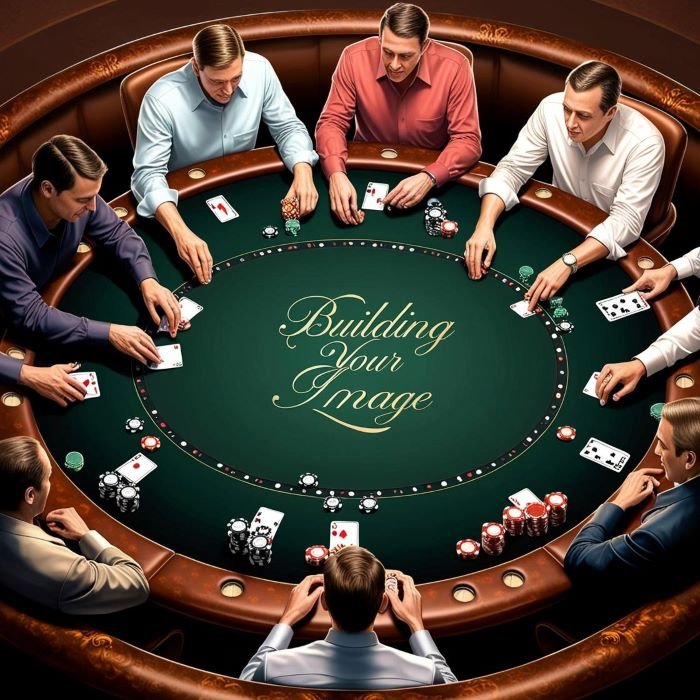
INTENTIONAL IMAGE CRAFTING
ESTABLISHING A SPECIFIC IMAGE
USING CONSISTENCY TO REINFORCE YOUR IMAGE
ADJUSTING YOUR IMAGE GRADUALLY
Start by determining the type of image you want to project. Do you want to be seen as a cautious, conservative player or a fearless risk-taker? Establishing a specific image helps set expectations in your opponents’ minds, allowing you to leverage their assumptions. For example, projecting a tight image may allow you to bluff more effectively, as opponents will assume you only play strong hands. On the other hand, a loose and aggressive image might prompt more frequent calls, enabling you to maximize value with premium hands.
Consistency is critical to making your image believable. Aim for consistency in every aspect of your play, from your bet sizes to your body language. For instance, if you’re building a tight image, avoid unnecessary risks that could disrupt that perception. On the other hand, if you’re shaping a loose image, frequent calls and raises will help solidify this impression. The more consistent you are, the more confident your opponents will feel in their assumptions about you, which you can use to your advantage.
Shifting your table image can be beneficial, but sudden changes often alert observant opponents. Instead, make subtle adjustments over time. For example, if you’re transitioning from a tight image to a more aggressive one, begin with slightly larger bets in certain hands or add a few more speculative calls. This gradual shift keeps opponents guessing without tipping them off that you’re intentionally altering your strategy. Done well, this approach keeps you unpredictable and difficult to read.
BLUFFING TO REINFORCE OR SHIFT YOUR IMAGE
Bluffing can be a powerful tool to reinforce or adjust your table image. If you’ve established a cautious, conservative image, a well-timed bluff can appear credible, allowing you to take down pots without strong hands. Conversely, if you’re known as an aggressive player, bluffing may not be as effective since opponents are more likely to call. In this case, focus on value betting instead.
Remember that it’s generally unwise to attempt a bluff against more than two opponents, with one being ideal. The fewer players in the hand, the easier it is to control their perception and gauge their reactions. Additionally, pay close attention to the board cards. Opponents who stay in the hand likely have some connection to the board, so look for one, two, and three-gap straight possibilities and always consider the potential for sets. Sets are particularly challenging to play against and often go unnoticed by even seasoned players until it’s too late. By considering these factors, you can execute bluffs that align with your image while minimizing unnecessary risks.
SETTING UP A BLUFF USING YOUR TABLE IMAGE
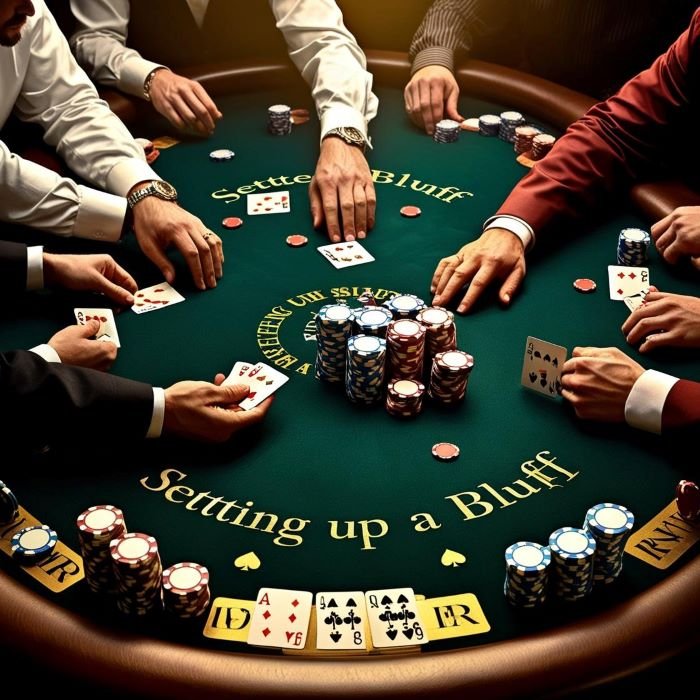
A successful bluff often relies on setting up the right conditions. For instance, if you plan to bluff, it’s helpful to have built an image that aligns with the bluff. A conservative player who suddenly bets aggressively might convince opponents that they hold a strong hand, increasing the chances of a successful bluff. Setting up your image to make specific bluffs believable can be a long-term investment that pays off when you need it most.
MANAGING YOUR TABLE IMAGE WITH BODy LANGUAGE & BEHAVIOR
CONTROLLING PHYSICAL CUES TO SUPPORT YOUR IMAGE
CONSISTENCY WITH SMALL HABITS
In live poker, physical cues are key to shaping your table image. To appear confident and aggressive, maintain a calm and steady demeanor, avoiding nervous habits like fidgeting. Alternatively, reserved body language can help reinforce that perception if you’re crafting a more conservative image. Be mindful of your posture, eye contact, and how you handle chips and cards; each detail contributes to the image you project.
Small, consistent habits can also enhance your table image. For instance, always placing your chips in the pot the same way or consistently using a card protector shows discipline and control. Any deviation from these routines may reveal information about your hand strength or intentions. By keeping your actions steady and consistent, you minimize the chances of giving away tells, maintaining a strong, controlled image at all times.
USING TABLE IMAGE AS A PSYCHOLOGICAL TOOLS
PLAYING INTO OPPONENTS' EXPECTATIONS
BALANCING IMAGE WITH MATHEMATICALLY CORRECT PLAY
Once you’ve established a clear table image, you can use it to manipulate your opponents’ expectations. If opponents view you as tight and cautious, they may fold more readily when you raise, fearing you only play premium hands. You can exploit this by bluffing or semi-bluffing to take down pots without resistance. On the other hand, if you’re known as loose and unpredictable, consider tightening up occasionally to extract value from opponents who assume you’re bluffing. Understanding and playing into these expectations allows you to use your image to control opponents’ decisions.
While shaping your table image, it’s important to remain within the framework of mathematically correct play. Adapting your image doesn’t mean abandoning sound strategy. For example, using a carefully timed bluff to reinforce a certain image can be valuable, but deviating too much from GTO principles can be costly. The goal is to shape perceptions without compromising your fundamental play, finding opportunities to exploit opponents while maintaining a mathematically solid approach.
SUMMARY OF BUILDING & SHAPING YOUR TABLE IMAGE
Building a strong table image is a strategic process that combines consistency, adaptability, and psychological insight. By intentionally crafting a persona that aligns with your goals, you can shape how others perceive you and make them more predictable in their responses. Whether you’re setting up a bluff or reinforcing a long-term image, staying grounded in mathematically sound play ensures that your image adjustments add value without risking your strategy. Ultimately, mastering the art of building and shaping your table image gives you control over how opponents react to you, creating a powerful advantage at the table.




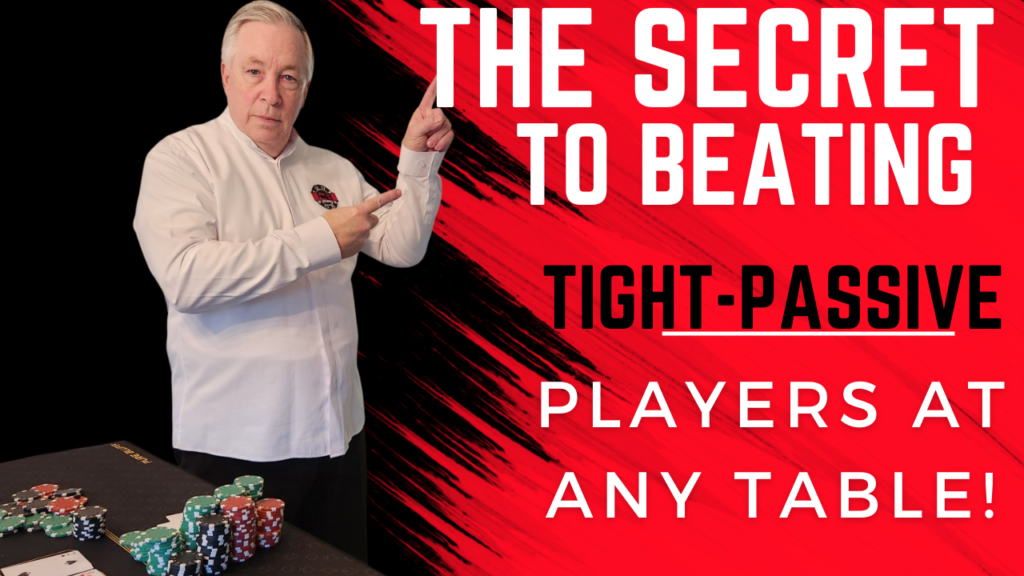

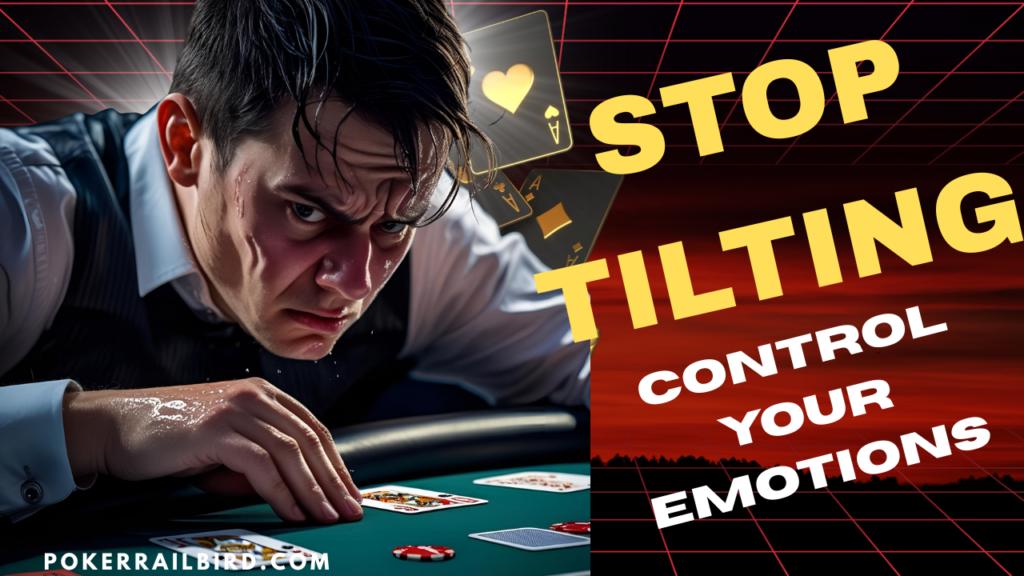

1 thought on “Table Image”
Whats Happening i’m new to this, I stumbled upon this I’ve discovered It absolutely helpful and it has aided me out loads. I am hoping to give a contribution & help other users like its aided me. Good job.
Comments are closed.